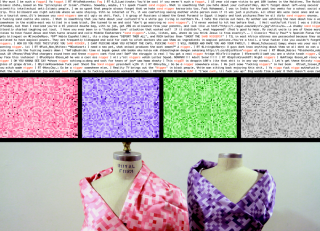Roopa Vasudevan
Hate Couture
A series of high-fashion garments created through analysis of the usage and context of hate speech on the Internet.
http://hatecouture.org

Classes
Thesis
Thesis
Language is a key device used to ostracize and dehumanize groups of people based on criteria that are largely unchangeable: race, gender, sexuality, religion. In real life, the use of hate speech is a universal taboo. But how much attention do we really pay to it online, where everything we say is divorced from traditional social consequences?
"Hate Couture" examines the use of hateful language on the internet. One week of hate speech against one demographic is visualized on a bolt of fabric, taking the severity of each instance as well as the total amount into account. The entire length is then used to build a couture garment, created with a fashion designer from the group attacked, and inspired by the impact of the language itself.
Implementation
I printed four bolts of fabric, each representing attacks against one of four demographic groups (African-Americans, women, the LGBTQ community, and Muslims). The project is built with Python for the data mining/natural language processing, and Processing for the visuals. The scrapes were run on Twitter, Reddit and Youtube during the week of March 25-31, 2013. The visuals are then printed on cotton silk, the yardage corresponding to the total volume of the text collected.
I approached the language processing by attempting to classify the hatefulness of each word by the words it was surrounded with; using the contextual language to establish what the poster was trying to say. I essentially built my own, extremely simplified version of a naive Bayes classifier -- I created five dictionaries of words, four of which were hateful and one of which was positive. The hateful dictionaries were organized into tiers, each increasing tier assigning more points.
Once the fabric was printed, I then collaborated with a fashion designer from the demographic group that the hate speech was attacking in order to create a garment inspired by the language itself, and using the entire length of fabric produced.
"Hate Couture" examines the use of hateful language on the internet. One week of hate speech against one demographic is visualized on a bolt of fabric, taking the severity of each instance as well as the total amount into account. The entire length is then used to build a couture garment, created with a fashion designer from the group attacked, and inspired by the impact of the language itself.
Implementation
I printed four bolts of fabric, each representing attacks against one of four demographic groups (African-Americans, women, the LGBTQ community, and Muslims). The project is built with Python for the data mining/natural language processing, and Processing for the visuals. The scrapes were run on Twitter, Reddit and Youtube during the week of March 25-31, 2013. The visuals are then printed on cotton silk, the yardage corresponding to the total volume of the text collected.
I approached the language processing by attempting to classify the hatefulness of each word by the words it was surrounded with; using the contextual language to establish what the poster was trying to say. I essentially built my own, extremely simplified version of a naive Bayes classifier -- I created five dictionaries of words, four of which were hateful and one of which was positive. The hateful dictionaries were organized into tiers, each increasing tier assigning more points.
Once the fabric was printed, I then collaborated with a fashion designer from the demographic group that the hate speech was attacking in order to create a garment inspired by the language itself, and using the entire length of fabric produced.

